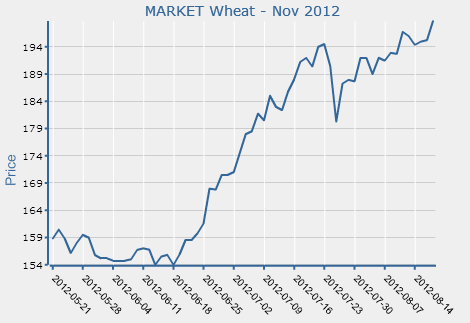August 19, 2012
Time for the Food Versus Fuel Debate?
At the end of last month the "Summer Olympics Special" edition of Time magazine carried a picture of Jessica Ennis on the cover. Just inside, however, was a double page photograph of "A bulldozed field in Geff, Illinois", together with the information that "A drought devastating stretches of the U.S. has forced many farmers to destroy their failed crops". That was accompanied on the Time web site by a series of photographs and an article entitled "The Great Drying Strikes Again". Time pointed out that:
The drought of 2012 keeps getting worse. On July 26, the federal government reported that more than two-thirds of the continental U.S. is drier than normal, with 20% of the country in one of the two most extreme stages of drought, up from just 7% a week before. In key agricultural states like Illinois, the situation is dire: nearly three-quarters of that corn-producing region’s land is in exceptional or extreme drought.
Time added that:
The extended dry spell and the record-breaking temperatures that have gripped much of the U.S. this year have brought climate change back to the attention of the public. Some 70% of Americans now say they believe that the world is growing warmer, up from 58% two years ago. Richard Muller, a physicist at the University of California-Berkeley and a longtime climate change skeptic, took to the pages of the New York Times this week to announce that he is now convinced that global warming is real and that man-made greenhouse gas emissions are responsible for most of it.
In that article Mr. Mueller, professor of physics at the at the University of California, Berkeley, said that:
Three years ago I identified problems in previous climate studies that, in my mind, threw doubt on the very existence of global warming. Last year, following an intensive research effort involving a dozen scientists, I concluded that global warming was real and that the prior estimates of the rate of warming were correct. I’m now going a step further: Humans are almost entirely the cause.
Going back to Time once more, they point out that:
It’s far from clear exactly what role climate change may be playing in the drought of 2012. Attributing a weather event to global warming in real time is impossible, and natural phenomena like the recent La Nina, which usually produces hotter and drier weather to the southern U.S., likely play a much more immediate role than broad-scale, climate patterns. But all that means is that there are at least two engines—short-term and long-term—driving the thermometer up.
The thermometer isn't the only thing going up, so is the price of a range of agricultural commodities, here in the the United Kingdom as well as over on the other side of the Atlantic. This weekend Farming Online reports on the U.S. drought that:
Over the past few days conditions have improved slightly from July’s dry weather and baking heat; light rains and cooler temperatures have helped to palliate all but the worst affected regions. However, rainfall has been too late and too scant to improve the condition of maize and soy crops, both of which had been continuously downgraded until this week, sparking market rallies and leading to spiralling grain prices, which the UN Food and Agriculture Organisation has warned will hinder access to food and may start another food crisis.
Drought in Russia and India, where a weak monsoon has affected agricultural regions in the North and West, have also contributed to concern over the availability and affordability of a range of staple grains this year. Yesterday, in spite of increased production in the United States, USDA said further rises could be expected in wheat prices, which already reached all-time highs last week.
Earlier last week the United Kingdom's Agriculture and Horticulture Development Board reported on their HGCA web site that:
The Ensus plant at Wilton, Teesside has announced that it expects to open later this month. The plant has been closed since May 2011 but has been undertaking maintenance and engineering works in recent months to ready the system for operation. At full capacity the plant can use 1Mt of wheat per year to produce around 400M litres of bioethanol and 350kt of DDGS animal feed. However, it is expected to take two months for the plant to ramp up to full operation. The closure of trade loopholes and poor US maize crop mean that competition from US ethanol is weakened and this is one reason for the improvement in market conditions for UK ethanol production.
What constitutes an "improvement in market conditions" for Ensus may not necessarily seem that way to the rest of us however. What do you suppose happens if supplies of grain decrease, whilst a greater proportion of that supply is turned from food into fuel? To help you answer that question, here's a chart of what wheat futures prices in London have been doing recently:
Filed under Climate by

Leave a Comment